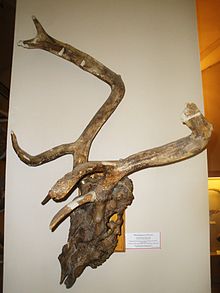Praemegaceros
| Praemegaceros Temporal range: Early Pleistocene to Holocene
| |
|---|---|

| |
| Skull of P. obscurus | |
| Scientific classification | |
| Domain: | Eukaryota |
| Kingdom: | Animalia |
| Phylum: | Chordata |
| Class: | Mammalia |
| Order: | Artiodactyla |
| Family: | Cervidae |
| Subfamily: | Cervinae |
| Genus: | †Praemegaceros Portis, 1920 |
| Species | |
| |
| Synonyms | |
| |


Praemegaceros is an extinct genus of deer. It also contains the subgenera Orthogonoceros and Nesoleipoceros. It has sometimes been synonymised with Megaloceros, however they have been found to have been genetically distinct.[1]
P. obscurus is the earliest known species from the Early Pleistocene of Europe, and had long, crooked antlers. P. verticornis is an Early to Mid-Pleistocene species, closely related to P. obscurus, which lived throughout Southern Europe.[2][3] Praemegaceros fossils has been discovered in France, Georgia, Germany, Greece, Israel, Italy, Romania, Russia Spain, Syria, and Tajikistan.[4][5][6]
P. cazioti survived into the Late Pleistocene and the Holocene, in isolation in Sardinia until human colonisation in 5500 BCE.[7]
References
- ^ CROITOR, R., 2006. Taxonomy and systematics of large-sized deer of the genus Praemegaceros Portis, 1920 (Cervidae, Mammalia). In: R. D. Kahlke, L. C. Maul, P. P. A. Mazza (Eds.): Late Neogene and Quaternary biodiversity and evolution: Regional developments and interregional correlations. Volume I. Courrier Forsch.-Institut Senckenberg, 256, 91-116.
- ^ Croitor, R. (2006). "Taxonomy and systematics of large-sized deer of the genus Praemegaceros Portis, 1920 (Cervidae, Mammalia)". In Kahlke, R.D.; Maul, L.C.; Mazza, P.P.A. (eds.). Late Neogene and Quaternary Biodiversity and Evolution: Regional Developments and Interregional Correlations. Vol. 1. Stuttgart, Germany: Schweizerbart. pp. 91–116. ISBN 978-3-510-61383-0.
- ^ Abbazzi, Laura (2004). "Remarks on the validity of the generic name Praemegaceros portis 1920, and an overview on Praemegaceros species in Italy". Rendiconti Lincei. 15 (2): 115–132. doi:10.1007/BF02904712.
- ^ "Fossilworks: Praemegaceros". fossilworks.org. Retrieved 2016-05-27.
- ^ Croitor, Roman (2006-11-15). "Taxonomy and systematics of large-sized deer of the genus Praemegaceros PORTIS, 1920 (Cervidae, Mammalia)". CFS Courier Forschungsinstitut Senckenberg. 256 (256). ISSN 0341-4116.
- ^ Croitor, Roman (2014-09-30). "A skull of Praemegaceros pliotarandoides (Cervidae, Mammalia) from the Taman Peninsula (South-West Russia)". 7.
{{cite journal}}: Cite journal requires|journal=(help) - ^ Belardo, Michael (2015-11-19). Italy, Thru My Lens. Strategic Book Publishing & Rights Agency. ISBN 9781631359859.
